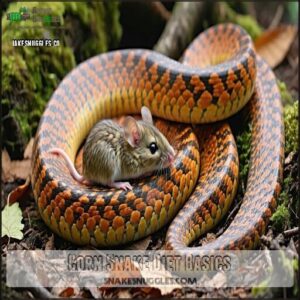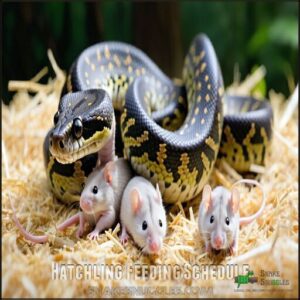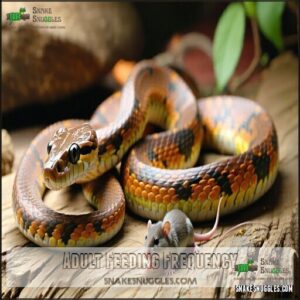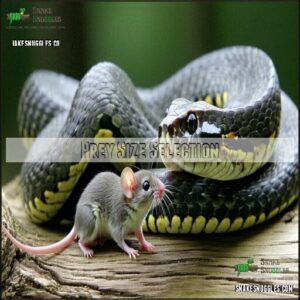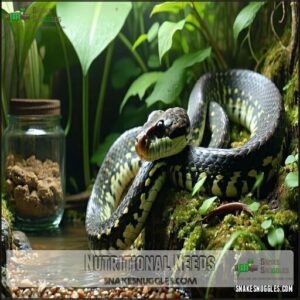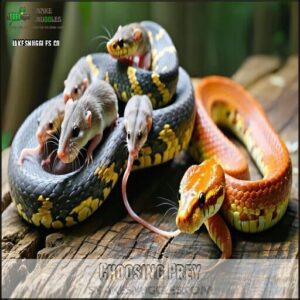This site is supported by our readers. We may earn a commission, at no cost to you, if you purchase through links.
 Your corn snake’s diet consists primarily of mice, which you’ll feed based on your snake’s size—pinkies for babies, adult mice for grown snakes.
Your corn snake’s diet consists primarily of mice, which you’ll feed based on your snake’s size—pinkies for babies, adult mice for grown snakes.
They’re natural rodent hunters, so this mimics what corn snakes eat in the wild. You’ll want to offer pre-killed frozen mice (thawed to room temperature) rather than live prey to prevent injury to your snake.
Feed hatchlings every 5-7 days and adults every 7-10 days. Proper prey size should create a small bulge in your snake’s body after feeding.
Maintaining this natural diet guarantees your scaly friend gets all the essential nutrients without supplementation.
Table Of Contents
- Key Takeaways
- Corn Snake Diet Basics
- What Do Corn Snakes Eat
- Feeding Corn Snakes
- Nutritional Needs
- Choosing Prey
- Frequently Asked Questions (FAQs)
- What to feed a corn snake?
- What do baby corn snakes eat?
- Do corn snakes eat rodents?
- Do corn snakes eat fish?
- Can a corn snake survive on a vegetarian diet?
- Do corn snakes eat at night?
- What can I feed a corn snake?
- Can you feed corn snakes anything other than mice?
- How often do corn snakes eat?
- Do corn snakes eat fruit?
- Conclusion
Key Takeaways
- You’ll need to feed your corn snake primarily mice, sized appropriately for your snake’s body (about 1-1.5 times their mid-body width).
- You should follow a consistent feeding schedule—every 5-7 days for hatchlings, 7-10 days for juveniles, and 10-21 days for adults.
- You’ll want to use frozen-thawed prey instead of live mice to prevent injury to your snake and ensure a safer feeding experience.
- You can occasionally offer variety with rats, small birds, or quail eggs to mimic their natural diet, but mice should remain their staple food.
Corn Snake Diet Basics
Corn snakes thrive on a rodent-based diet, with mice and small rats being their primary food sources.
To support their health, you should provide prey that matches their size and offer occasional variety to mimic their natural diet.
Primary Food Sources
Corn snakes thrive on a rodent-based diet, which closely mirrors their wild diet.
Their primary food sources include:
- Mice: Common in snake food choices, offering excellent nutritional content.
- Rats: Suitable for larger snakes, a key part of a balanced rodent diet.
- Bird Eggs: Occasionally added for prey variety, though not a staple.
Ethical concerns favor feeding frozen prey.
Importance of Prey Variety
A diverse prey selection keeps your snake healthier, supporting peak growth, enhanced immunity, and avoiding deficiencies.
Wild snakes naturally eat various prey; replicating this enriches captive diets. Including different prey types, like small birds, rodents, or eggs, mimics nature’s variety.
A varied diet keeps your corn snake thriving—boosting growth, enhancing immunity, and mimicking nature’s perfect balance.
| Benefits of Variety | Example Prey | Impact on Nutrition |
|---|---|---|
| Nutrient Diversity | Quail eggs | Promotes balanced health |
| Healthier Snakes | Small lizards | Improves digestion |
| Avoiding Deficiencies | Pinkie mice | Provides key nutrients |
The benefits of a varied diet for snakes are clear, with healthier snakes resulting from a mix of prey types, and a reduced risk of deficiencies when including items like pinkie mice.
Avoiding Poor Food Choices
Avoid toxic prey like toads—they can harm your snake.
Stick to high-quality options like mice for snakes, ensuring good snake nutrition.
Feeding corn snakes pinky mice reduces calcium deficiency risks.
Overfeeding can lead to obesity risks, while prolonged fasting dangers shouldn’t be ignored.
Unsafe handling post-meal can cause regurgitation.
Keep your corn snake diet balanced and safe!
Captive-bred prey helps avoid parasites and diseases to ensure a healthy diet.
What Do Corn Snakes Eat
When feeding corn snakes, remember their natural habits often guide their preferences.
In the wild, their diet includes a variety of small animals.
Your pet corn snake benefits from a thoughtfully chosen menu.
Here’s what they eat:
- Mice for snakes: The go-to, both in the wild and captivity, providing essential protein.
- Bird consumption: Occasionally, corn snakes might enjoy chicks or eggs.
- Amphibian inclusion: Rarely part of their diet but possible with small frogs.
- Lizard intake: Wild corn snakes may hunt small reptiles when rodents are scarce.
- Avoid toad toxicity: Never feed toads—they’re unsafe for your snake.
Stick to nutritionally balanced prey like rodents to mimic their wild diet while keeping meals safe and digestible.
Hatchlings, for example, thrive on appropriately sized pinkie mice.
Feeding Corn Snakes
Feeding your corn snake properly is essential to its health and overall well-being.
Understanding the right schedule and prey size guarantees your snake gets the nutrition it needs at every stage of life.
Hatchling Feeding Schedule
A corn snake hatchling thrives when fed pinkie mice every 5-7 days.
Stick to prey that matches its pinky size and warm it properly to avoid regurgitation risks.
Be patient with the feeding schedule, as overfeeding can harm its growth.
Monitor hydration and avoid handling during meals.
Early supplementation needs are minimal if pinkies are appropriately thawed.
Hatchlings typically require feeding every five to seven days.
Adult Feeding Frequency
Adult corn snakes thrive on a steady feeding schedule to prevent obesity.
A consistent feeding routine keeps adult corn snakes healthy, avoiding obesity while ensuring proper nutrition and well-being.
Typically, an adult over 35 inches eats every 14-21 days, with adjustments based on activity and metabolism.
Overfed snakes face regurgitation risks, while underfed ones need closer intervals, around 10-14 days.
Seasonal variations may affect prey digestion too.
A balanced snake feeding guide promotes healthy fasting periods and overall well-being.
To maintain a healthy weight, it’s vital to practice consistent portion control and follow a consistent portion control plan for healthy nutrition.
Prey Size Selection
For corn snakes, choosing prey with prime dimensions is key.
The prey’s width shouldn’t exceed 1.5 times your snake’s body width.
Weight considerations matter too—prey should be about 10% of their weight.
Pinkie mice suit hatchlings, while adults can handle fuzzies or larger sizes.
Proper nutritional content guarantees safe consumption and supports digestive capabilities, keeping your snake healthy and thriving with proper care.
Nutritional Needs
To keep your corn snake healthy, you need to provide more than just the right prey size.
It’s vital to make certain their diet includes proper levels of vitamins, calcium, and hydration to support their growth and overall well-being.
Vitamin a for Health
Through proper whole prey feeding, your corn snake typically receives adequate Vitamin A for vision support and liver health.
Natural vitamin sources from mice and rats generally suffice in a varied reptile diet.
Watch for deficiency symptoms like eye discharge, lethargy, or skin tears.
Supplementation risks include hypervitaminosis A, causing skin sloughing and kidney damage.
If you notice issues when snake feeding, consult a reptile veterinarian before adding supplements.
Calcium for Bone Growth
Just as vitamin A supports healthy vision, calcium plays a starring role in your corn snake’s skeletal development. Without sufficient calcium, your pet risks developing metabolic bone disease (MBD), a painful condition causing weakened bones and deformities.
- Your snake’s prey mightn’t provide enough calcium naturally, leaving your pet vulnerable to fractures
- Watching a snake struggle with MBD can be heartbreaking as they lose mobility
- Proper supplementation feels like giving your snake a protective shield against suffering
- The pride of seeing your corn snake grow strong with proper calcium absorption is immensely satisfying
Calcium supplements should be dusted onto prey items regularly, especially during growth stages when bone density development is most critical. UVB lighting works hand-in-hand with dietary supplements, enhancing calcium absorption for your reptile’s diet.
Hydration Requirements
Beyond calcium, water plays a fundamental role in your corn snake’s health.
While these reptiles evolved in semi-arid regions, they still need consistent hydration to thrive in captivity.
| Hydration Need | Signs to Watch | Solutions | Importance |
|---|---|---|---|
| Daily Water | Clear, full bowl | Fresh water daily | Prevents dehydration |
| Shedding Hydration | Stuck shed, dull eyes | Increase humidity | Maintains complete shed |
| Humidity Levels | Respiratory issues | Monitor with hygrometer | Maintains respiratory health |
| Bathing Frequency | Dehydration signs | Shallow water dish | Aids hydration & shedding |
Choosing Prey
You’ll need to select prey that’s approximately 1-1.5 times the width of your corn snake’s body to prevent feeding difficulties and potential health issues.
Choosing between frozen-thawed rodents (the safest option) and appropriately sized prey varieties will guarantee your snake receives proper nutrition while minimizing the risk of injury that can occur with live feeding, which is a key consideration for potential health issues.
Prey Size and Type
When selecting prey for your corn snake, matching size to your snake’s body width is vital. The prey item should never exceed 1.5 times your snake’s mid-body diameter.
- Pinkies (newborn mice) are perfect for hatchlings
- Fuzzies suit juvenile snakes as they grow
- Adult mice support mature corn snakes’ nutritional needs
- Occasional rodent alternatives provide enrichment
- Wild prey risks include parasites and disease
Remember, proper snake prey selection directly impacts your pet’s health and digestion. Consistent sizing helps facilitate easy swallowing and prevents digestive issues, which is essential for your pet’s well-being.
Feeding Live Vs Frozen Prey
Choosing the right prey format is as important as selecting proper prey size.
While some snakes initially prefer live prey, frozen mice offer significant safety advantages.
Live rodents can inflict serious injuries to your corn snake, sometimes fatal ones.
Frozen prey eliminates these risks, kills potential parasites, and is considered more humane.
You’ll find thawed prey works well when wiggled slightly to trigger your snake’s feeding response—mimicking live movement without the dangers.
Many owners reliably source quality reptile feeders online, which provides a convenient way to obtain frozen mice and other quality reptile feeders.
Prey Variety for Balanced Diet
While frozen mice form the foundation of captive corn snake diets, variety mirrors their wild diet and prevents nutritional deficiencies.
You can occasionally offer appropriately-sized rats, quail eggs, or day-old chicks as supplemental options.
This prey enrichment strategy provides different nutrient profiles and stimulates natural hunting behaviors.
When sourcing prey, choose ethical suppliers who humanely raise feeder rodents specifically for reptile consumption.
Your snake will benefit from this balanced approach to feeding, which includes selecting prey from humane sources.
Frequently Asked Questions (FAQs)
What to feed a corn snake?
As hungry as a hunter, your corn snake needs primarily mice.
You’ll feed babies pinkies every 5-7 days, juveniles mice every 7-10 days, and adults mice or small rats every 10-21 days.
What do baby corn snakes eat?
Baby corn snakes primarily eat pinkie mice, which are hairless newborn mice. You’ll need to provide fully defrosted, warm pinkies every 5-7 days, sized appropriately for your snake’s small body.
Do corn snakes eat rodents?
Yes, corn snakes primarily eat rodents in both wild and captive settings.
You’ll find they specialize in mice and rats, which form the foundation of their diet.
They’re excellent rodent controllers by nature.
Do corn snakes eat fish?
No, corn snakes don’t typically eat fish in their natural diet.
You’ll find they prefer rodents like mice and rats, occasionally consuming birds, lizards, and eggs.
Fish lack necessary nutrients for their best health.
Can a corn snake survive on a vegetarian diet?
No, your corn snake can’t survive on vegetables.
They’re obligate carnivores requiring whole animal prey, primarily rodents.
Their digestive system isn’t designed to process plant matter, and they’ll starve without proper meat-based nutrition.
Do corn snakes eat at night?
Dusk-dwelling devourers, corn snakes primarily hunt and eat at night.
Their crepuscular nature means you’ll often find them most active during dawn and dusk when they’re searching for their next rodent meal.
What can I feed a corn snake?
You should feed your corn snake primarily frozen-thawed mice sized appropriately for your snake’s body width.
Pinkies work for hatchlings, while adults need adult mice every 10-14 days.
Always avoid live prey.
Can you feed corn snakes anything other than mice?
Like nature’s opportunists in the wild, you can offer your corn snake rats, small birds, quail eggs, or chicks as occasional treats.
They’re primarily rodent specialists though, so mice should remain their staple diet.
How often do corn snakes eat?
You should feed your corn snake based on its age: hatchlings every 5-7 days, juveniles every 7-10 days, and adults every 10-21 days.
Always adjust feeding frequency if your snake’s showing signs of obesity or hunger.
Do corn snakes eat fruit?
No, your corn snake won’t eat fruit.
They’re strictly carnivorous reptiles that require whole animal prey, primarily rodents like mice.
Their digestive systems aren’t designed to process plant matter at all.
Conclusion
Picture your corn snake thriving on a diet that mirrors what corn snakes eat in the wild—primarily mice sized appropriately for their growth stage.
By maintaining a consistent feeding schedule, selecting proper prey size, and using pre-killed food, you’ll support your snake’s health for years to come.
Remember, understanding what corn snakes eat isn’t just about nutrition—it’s about respecting their natural hunting instincts while ensuring their safety in captivity. Your dedication to proper feeding shows in your snake’s vibrant appearance and activity level.
Consistent feeding schedule, proper prey size, and pre-killed food

